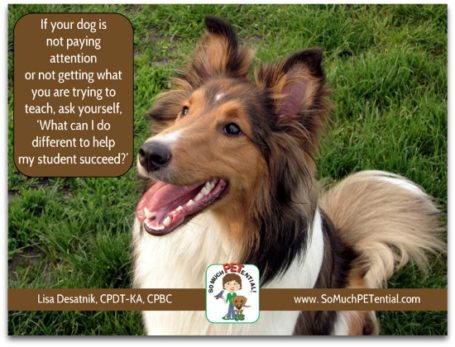(Note that this was actually written several years ago for something. I just found a copy of it.)
I was thinking about this the other day when I was working on teaching our family dog, Sam, a new behavior. I was working on teaching him the leg weave (where he runs around a leg when you move it in a direction, then around the other leg), and he lost interest very quickly in the beginning.
 I could have simply blown it off to his being stubborn or dumb, but I know better than that.
I could have simply blown it off to his being stubborn or dumb, but I know better than that.
I know that if an animal I am training is not getting the lesson plan, and would rather do other things at the time, that the animal is simply giving me feedback that I am not teaching in a way that motivates him to want to stay in the classroom.
So I took a step back and thought about what I was doing.
Was I setting him up for success or was I setting him up for failure?
These are some questions I needed to ask:
Was the environment too distracting? (Remember, it is important when teaching a new behavior that you begin in an environment with minimal or no other distractions so as to have your animal’s full attention. You only add distractions slowly as your student tells you by his ability to focus on doing the behavior that he is ready for it.)
Did I have high enough value reinforcers? (Please read my post on why knowing your pet’s List of Awesomeness is important)
How was my timing between when he did a behavior approximation and when I gave the reinforcement? (The shorter the time lapse between when the behavior occurs and the reinforcement is produced, the easier it is for the animal to learn that association.)
Was I going at the right pace for him? (In my shaping plan, were my behavior approximations at an interval that were enough to teach but not so much as to be too difficult? See my post on shaping.)
Was I completely focused on the training so as to catch his behaviors that I wanted to reinforce?
Was my training session short? (Training sessions should be short, 3 to 5 minutes, ending on a positive note.)
In this particular lesson, it was a very quiet living room with minimum distractions and so I was not using the highest value reinforcer. I was using Sam’s dog biscuits. Also, while I began teaching this by luring him around my leg (having him follow a treat), I did not give him a piece of the treat until he was half way around the leg.
That combination was not setting him up for success. Waiting until he moved half way around my leg was way too long of an approximation to keep his interest, especially when his reinforce for doing so was a piece of dog biscuit.
What did I do? I added some pieces of chicken to my reinforcer bag and, while I used luring at the beginning, I marked (and gave him a reinforcer) for his moving around my leg in very small increments the first few times. There were six locations around my leg that were my target points for marking and reinforcing.
That small change made a huge impact. In only a few trials, Sam was running around my leg and then around the other.
Next, I stopped at that success and practiced another behavior for a couple minutes, then another behavior for another couple minutes, and then went back to the leg weaves. Wow, was he charging around my leg by that point. I had made my classroom so much fun for him that he forgot he was there to learn…but learn he did! And with gusto!
The next step was to begin fading out the lure and using less frequent target points around my leg until I could get to the point where I would just give a hand cue and he’d begin to weave. Now we are working on shifting to just my leg movement as his cue to begin the weave.
My point with this post is that, whenever you are training an animal who just simply is not doing what you want him to do. Know that there is always a reason. And it is not that your animal is dumb or stubborn. As your pet’s teacher, step back and think through what you can do to make the lesson plan easier, more clear…and definitely more fun!








